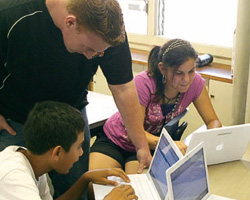
As the computing world moves from stand-alone programs to cloud computing, Google for Educators (informally known as Google education) is providing a platform for this shift to take place in classrooms. The ULS faculty, along with information technology (IT) and learning technology (LT) staff from CRDG, are using this opportunity to explore all the ways this new technology can support teaching and learning. Research projects range from assembling, or in some cases creating, the hardware and software to build an integrated system within the school, to developing ways cloud computing can enhance classroom activities, to looking at the safety issues this new open environment raises. A key component of the research is to look at whether the new tools are actually enhancing student learning.

Cloud computing offers many advantages for a school environment, both solving problems and creating new opportunities. One of the biggest advantages is that it eliminates the problems associated with transferability between home and school. Going a step further, it allows students to collaborate on a single document no matter where they are, and to have the file waiting for them when they get to school. And all of this happens within a safe online environment, since students’ documents or chats can only be shared within the intranet created by the school.
Another big advantage of the Google for Educators system is the tremendous increase in capacity that is created by the allocation of 7.5 giga-bytes of storage space to every student, allowing for new applications in the classroom. As an example of what can be done, as teachers and students mark up a SMART Board during class, all of the notes and drawings are captured back to the computer, which students can then look at and add to at home. “This is an especially good match for our school,” said CRDG IT manager Mark Yap, “because of our inquiry approach.”
The new cloud computing environment and the possibilities it creates have led to a series of need-based technology workshops for teachers. Six workshops in the spring of 2009 all originated from teachers expressing a need or interest and called on the expertise of the entire CRDG IT/LT team. In addition, a new technology committee made up of ULS teachers along with IT and LT staff from CRDG is examining the way technology is shaping the school and creating a plan for where they want to go.
As the new cloud computing concept starts to take hold in the school, teachers are discovering new ways to solve problems and enhance learning. In English, some students started using Google Docs as a way to address compatibility issues, composing their papers in Google Docs when they couldn’t open school files at home. Once students began writing their papers in that format, teacher Marybeth Hamilton began using it to add feedback, and by the end of their first semester, the idea of sharing documents and of doing an entire project, from first draft to finished paper, in Google Docs had caught on and was being used by the entire class. As the year ended, plans were being made to use the new technology for collaborative writing and podcasting projects.
Eighth grade mathematics teacher Brendan Brennan is also using an interactive classroom to transform the way his students learn math. He combines the Google for Educators tools with a TI Navigator system to create a classroom where all kids get involved. The technology changes the focus from what the teacher is doing to what the students are doing, and the quick, spontaneous discussions allow students to interact not only with the teacher, but with each other. Screen capture features allow the teacher to understand at a glance who is understanding the concept, who is close but not there yet, and who is way off base.

Brennan is also collaborating with CRDG mathematics researchers to look at curriculum development that includes technology from the earliest stages. “Too often, the current approach to technology is to put computers into the classroom without planning for how it will fit with what is already being done,” says Brennan, “so that teachers end up pairing inappropriate technology with antiquated curricula.” Studies show that in this kind of situation, the technology does not improve student learning. As part of a larger CRDG study, Brennan is studying how technology impacts student learning in his sixth grade classes where one group uses computers and the other uses traditional pencil and paper methods. “We want to understand how the new tools change what happens in the classroom. Do they allow for the class to move more quickly through the material? Do students take the lessons in different directions and explore new ideas? Do they gain a deeper understanding of the mathematics?” The goal of the research is to develop curriculum alongside technology to enhance student learning now and to better prepare students for the world they will live in after graduation.
